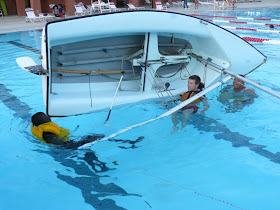
Any vessel can tip over. Here is the SS Normandie, one of the world's greatest ocean liners.
The first photo shows how majestic & powerful she was. Many people consider her the most beautiful ship ever built. For years the SS Normandie crossed the Atlantic Ocean carrying thousands of passengers in safety & luxury. No question of her stability.
.

The second photo shows how, after a seemingly minor accident, she capsized at the dock.
(link to history of the SS Normandie)
Our handout shows a Royal Navy (British) destroyer laying on her side after a battle. So, we know for sure that any vessel can be capsized.
.

By this time, our cadets have all experienced a capsize too. Small boats may actually have a greater range of stability, but they are also more likely to be overcome by sea & weather conditions. The ability to cope with a capsize is an important skill for any sailor.
A big "Thank You !!" to the Twin Rivers YMCA (link). It's great to have a calm & controlled environment to practice this skill.
.

Here are two beginner sailors... their very first time afloat in an FJ, actually... ready to show what they've learned. Don't they look dry? That's about to change!
Part of the fun is the advanced sailors get to handle the boat in the water. It's not just dunking your fellow cadets in the pool, it's serious training! All kidding aside, the two 'Blue Book' sailors who handled the FJ from the water did a great job. It's not as easy as it looks to keep the FJ centered and not hit anything with the hull or mast.
.

Everybody got to take a turn. When under stress, we do what we've drilled. This is why we practice the basic steps in order, the same way every time. Only a few New Bern cadets have capsized on the river, but when they did, they recovered quite well thanks to this practice.
This photo shows the last step, crew helping the skipper aboard. It can be surprisingly difficult to climb aboard a boat!
.

Here we see another basic lesson: DON'T STAND UP IN AN FJ!
But these two newbies did OK in the actual capsize drill.
.

Anybody can make a mistake, especially at something you've just begun. Here the crew looks rather nervous even though they've watched several other crews do the capsize drill first. But that's not the mistake... the skipper is not steering properly! How should the skipper be holding the tiller?
.

But all is well in this photo, the skipper & crew are in their places & doing their jobs.
The skipper has control of the boat by holding the centerboard. This prevents it from drifting away or turning all the way over "turtle." The crew rigs the righting line (orange rope laying over the rail) and then prepares to scoop into the boat as the skipper pulls it rightside up.
.

"All aboard !!"
The key to doing this: let the boat heel toward the person in the water. This lowers the side they have to climb over, and makes it easier for them to get a grip on the hiking strap to pull themselves in.
.

Here's three of our advanced sailors, two are practicing the capsize drill and one is handling the boat.
What, you expect one of us coaches to get in the water? Relax, we've done it a thousand times, now it's your turn!
This skipper & crew are just finishing up Step 1... makes sure that everyone on board is OK. They did a fine job.
.

Capsize drill completed smoothly, time to head back to port.
Remember how we said anybody can make a mistake? Well, this skipper has forgotten to hold the tiller at all, much less do it the right way!
.
.

Now all the fun is over. You can hear FJ #3 heave a sigh of relief! We unrig the boat completely, which is not a step we normally do... boom comes off, mast comes down, boat goes on trailer...
All is ready for Monday! Hope you're ready too!
... posted by Assistant Coach Douglas King
No comments:
Post a Comment